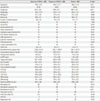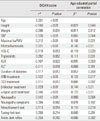1. American Heart Association. Heart Disease and Stroke Statistics-2005 update. 2005. Dallas, Tex: American Heart Association.
2. Gu K, Cowie CC, Harris MI. Mortality in adults with and without diabetes in a national cohort of the U.S. population, 1971-1993. Diabetes Care. 1998. 21:1138–1145.
3. Alexander CM, Landsman PB, Teutsch SM, Haffner SM. NCEP-defined metabolic syndrome, diabetes, and prevalence of coronary heart disease among NHANES III participants age 50 years and older. Diabetes. 2003. 52:1210–1214.
4. O'Neal DN, Dragicevic G, Rowley KG, Ansari MZ, Balazs N, Jenkins A, Best JD. A cross-sectional study of the effects of type 2 diabetes and other cardiovascular risk factors on structure and function of nonstenotic arteries of the lower limb. Diabetes Care. 2003. 26:199–205.
5. Sun K, Daimon M, Watanave S, Komuro I, Masuda Y. The relation of pulse wave velocity by oscillometric and tonometric methods and clinical application studies. Jpn J Appl Physiol. 2002. 32:81–86.
6. Aso K, Miyata M, Kubo T, Hashiguchi H, Fukudome M, Fukushige E, Koriyama N, Nakazaki M, Minagoe S, Tei C. Brachial-ankle pulse wave velocity is useful for evaluation of complications in type 2 diabetic patients. Hypertens Res. 2003. 26:807–813.
7. Maser RE, Mitchell BD, Vinik AI, Freeman R. The association between cardiovascular autonomic neuropathy and mortality in individuals with diabetes: a meta-analysis. Diabetes Care. 2003. 26:1895–1901.
8. Wheeler SG, Ahroni JH, Boyko EJ. Prospective study of autonomic neuropathy as a predictor of mortality in patients with diabetes. Diabetes Res Clin Pract. 2002. 58:131–138.
9. Silkensen JR, Kasiske BL. Brenner & Rector's the kidney: laboratory assessment of kidney disease. 2004. 7th ed. Philadelphia: W.B. Saunders Co.;1125–1126.
10. Kim EJ, Park CG, Park JS, Suh SY, Choi CU, Kim JW, Kim SH, Lim HE, Rha SW, Seo HS, Oh DJ. Relationship between blood pressure parameters and pulse wave velocity in normotensive and hypertensive subjects: invasive study. J Hum Hypertens. 2007. 21:141–148.
11. Gottsater A, Ryden-Ahlgren A, Szelag B, Hedblad B, Persson J, Berglund G, Wroblewski M, Sundkvist G. Cardiovascular autonomic neuropathy associated with carotid atherosclerosis in Type 2 diabetic patients. Diabet Med. 2003. 20:495–499.
12. Asmar R, Benetos A, Topouchian J, Laurent P, Pannier B, Brisac AM, Target R, Levy BI. Assessment of arterial distensibility by automatic pulse wave velocity measurement. Validation and clinical application studies. Hypertension. 1995. 26:485–490.
13. Kubo T, Miyata M, Minagoe S, Setoyama S, Maruyama I, Tei C. A simple oscillometric technique for determining new indices of arterial distensibility. Hypertens Res. 2002. 25:351–358.
14. Lee SW, Yun KW, Yu YS, Lim HK, Bae YP, Lee BD, Kim BH, Lee CW. Determinants of the brachial-ankle pulse wave velocity (baPWV) in patients with type 2 diabetes mellitus. J Korean Endocr Soc. 2008. 23:253–259.
15. Yun KW, Kim BH, Bae YP, Yi BD, Lee SW, Lim HK, Ryu YS, Lee CW. Determinants of 1-year changes of brachial ankle pulse wave velocity in patients with type 2 diabetes melllitus. Korean Diabetes J. 2008. 32:346–357.
16. Singh JP, Larson MG, Tsuji H, Evans JC, O'Donnell CJ, Levy D. Reduced heart rate variability and new-onset hypertension: insights into pathogenesis of hypertension: the Framingham Heart Study. Hypertension. 1998. 32:293–297.
17. Young LH, Wackers FJ, Chyun DA, Davey JA, Barrett EJ, Taillefer R, Heller GV, Iskandrian AE, Wittlin SD, Filipchuk N, Ratner RE, Inzucchi SE. Cardiac outcomes after screening for asymptomatic coronary artery disease in patients with type 2 diabetes: the DIAD study: a randomized controlled trial. JAMA. 2009. 301:1547–1555.
18. Unger RH, Foster DW. Wilson JD, Foster DW, Kronenberg HM, Larsen PR, editors. Diabetes mellitus. Williams Textbook of Endocrinology. 1998. 9th ed. Philadelphia: Saunders Co.;1024–1026.
19. Weston PJ, Gill GV. Is undetected autonomic dysfunction responsible for sudden death in Type 1 diabetes mellitus? The 'dead in bed' syndrome revisited. Diabet Med. 1999. 16:626–631.
20. Rathmann W, Ziegler D, Jahnke M, Haastert B, Gries FA. Mortality in diabetic patients with cardiovascular autonomic neuropathy. Diabet Med. 1993. 10:820–824.
21. Tentolouris N, Liatis S, Moyssakis I, Tsapogas P, Psallas M, Diakoumopoulou E, Voteas V, Katsilambros N. Aortic distensibility is reduced in subjects with type 2 diabetes and cardiac autonomic neuropathy. Eur J Clin Invest. 2003. 33:1075–1083.
22. Meyer C, Milat F, McGrath BP, Cameron J, Kotsopoulos D, Teede HJ. Vascular dysfunction and autonomic neuropathy in Type 2 diabetes. Diabet Med. 2004. 21:746–751.
23. Athyros VG, Didangelos TP, Karamitsos DT, Papageorgiou AA, Boudoulas H, Kontopoulos AG. Long-term effect of converting enzyme inhibition on circadian sympathetic and parasympathetic modulation in patients with diabetic autonomic neuropathy. Acta Cardiol. 1998. 53:201–209.
24. Didangelos TP, Arsos G, Karamitsos D, Athyros V, Georga S, Karatzas N. Effect of quinapril or losartan or their combination on diabetic autonomic neuropathy and left ventricular function. Diabetologia. 2002. 45:Suppl. 84.
25. Rabbia F, Martini G, Sibona MP, Grosso T, Simondi F, Chiandussi L, Veglio F. Assessment of heart rate variability after calcium antagonist and β-blocker therapy in patients with essential hypertension. Clin Drug Invest. 1999. 17:111–118.
26. Lopatin Iu M, Kirakozov DA, Statsenko ME. Heart rate variability in patients with hypertension and type 2 diabetes treated with long acting calcium antagonists. Kardiologiia. 2003. 43:33–36.
27. Chen J, Marciniak TA, Radford MJ, Wang Y, Krumholz HM. Beta-blocker therapy for secondary prevention of myocardial infarction in elderly diabetic patients. Results from the National Cooperative Cardiovascular Project. J Am Coll Cardiol. 1999. 34:1388–1394.
28. Liao D, Carnethon M, Evans GW, Cascio WE, Heiss G. Lower heart rate variability is associated with the development of coronary heart disease in individuals with diabetes: the atherosclerosis risk in communities (ARIC) study. Diabetes. 2002. 51:3524–3531.
29. Pop-Busui R, Sima A, Stevens M. Diabetic neuropathy and oxidative stress. Diabetes Metab Res Rev. 2006. 22:257–273.
30. Madamanchi NR, Runge MS. Mitochondrial dysfunction in atherosclerosis. Circ Res. 2007. 100:460–473.
31. Russell JW, Berent-Spillson A, Vincent AM, Freimann CL, Sullivan KA, Feldman EL. Oxidative injury and neuropathy in diabetes and impaired glucose tolerance. Neurobiol Dis. 2008. 30:420–429.










 PDF
PDF ePub
ePub Citation
Citation Print
Print



 XML Download
XML Download